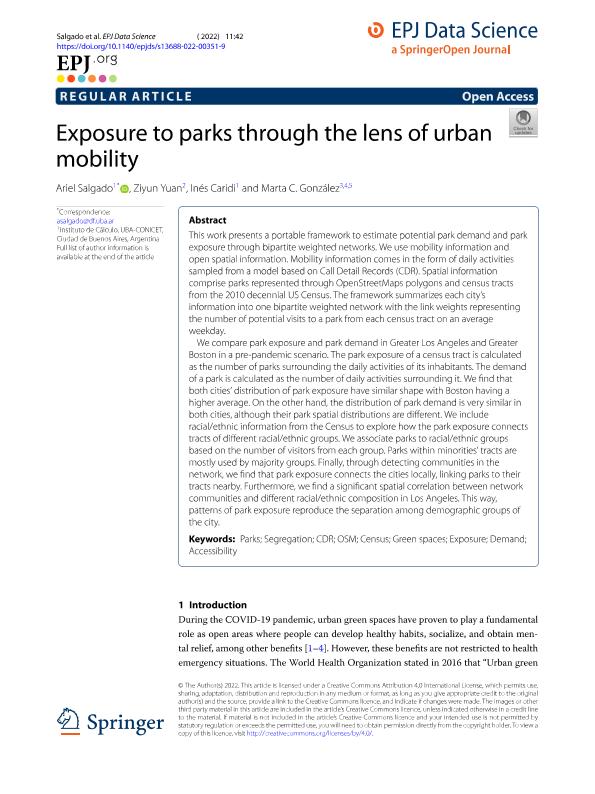Mostrar el registro sencillo del ítem
dc.contributor.author
Salgado Corrado, Ariel Olaf

dc.contributor.author
Yuan, Ziyun
dc.contributor.author
Caridi, Délida Inés

dc.contributor.author
González, Marta C.
dc.date.available
2023-07-13T10:32:34Z
dc.date.issued
2022-12
dc.identifier.citation
Salgado Corrado, Ariel Olaf; Yuan, Ziyun; Caridi, Délida Inés; González, Marta C.; Exposure to parks through the lens of urban mobility; Springer Science and Business Media Deutschland GmbH; EPJ Data Science; 11; 1; 12-2022; 1-21
dc.identifier.issn
2193-1127
dc.identifier.uri
http://hdl.handle.net/11336/203614
dc.description.abstract
This work presents a portable framework to estimate potential park demand and park exposure through bipartite weighted networks. We use mobility information and open spatial information. Mobility information comes in the form of daily activities sampled from a model based on Call Detail Records (CDR). Spatial information comprise parks represented through OpenStreetMaps polygons and census tracts from the 2010 decennial US Census. The framework summarizes each city’s information into one bipartite weighted network with the link weights representing the number of potential visits to a park from each census tract on an average weekday. We compare park exposure and park demand in Greater Los Angeles and Greater Boston in a pre-pandemic scenario. The park exposure of a census tract is calculated as the number of parks surrounding the daily activities of its inhabitants. The demand of a park is calculated as the number of daily activities surrounding it. We find that both cities’ distribution of park exposure have similar shape with Boston having a higher average. On the other hand, the distribution of park demand is very similar in both cities, although their park spatial distributions are different. We include racial/ethnic information from the Census to explore how the park exposure connects tracts of different racial/ethnic groups. We associate parks to racial/ethnic groups based on the number of visitors from each group. Parks within minorities’ tracts are mostly used by majority groups. Finally, through detecting communities in the network, we find that park exposure connects the cities locally, linking parks to their tracts nearby. Furthermore, we find a significant spatial correlation between network communities and different racial/ethnic composition in Los Angeles. This way, patterns of park exposure reproduce the separation among demographic groups of the city.
dc.format
application/pdf
dc.language.iso
eng
dc.publisher
Springer Science and Business Media Deutschland GmbH

dc.rights
info:eu-repo/semantics/openAccess
dc.rights.uri
https://creativecommons.org/licenses/by/2.5/ar/
dc.subject
ACCESSIBILITY
dc.subject
CDR
dc.subject
CENSUS
dc.subject
DEMAND
dc.subject
EXPOSURE
dc.subject
GREEN SPACES
dc.subject
OSM
dc.subject
PARKS
dc.subject
SEGREGATION
dc.subject.classification
Otras Ciencias Físicas

dc.subject.classification
Ciencias Físicas

dc.subject.classification
CIENCIAS NATURALES Y EXACTAS

dc.subject.classification
Ingeniería del Transporte

dc.subject.classification
Ingeniería Civil

dc.subject.classification
INGENIERÍAS Y TECNOLOGÍAS

dc.subject.classification
Estudios Urbanos

dc.subject.classification
Geografía Económica y Social

dc.subject.classification
CIENCIAS SOCIALES

dc.title
Exposure to parks through the lens of urban mobility
dc.type
info:eu-repo/semantics/article
dc.type
info:ar-repo/semantics/artículo
dc.type
info:eu-repo/semantics/publishedVersion
dc.date.updated
2023-07-03T16:24:57Z
dc.journal.volume
11
dc.journal.number
1
dc.journal.pagination
1-21
dc.journal.pais
Alemania

dc.description.fil
Fil: Salgado Corrado, Ariel Olaf. Universidad de Buenos Aires. Facultad de Ciencias Exactas y Naturales. Instituto de Calculo. - Consejo Nacional de Investigaciones Científicas y Técnicas. Oficina de Coordinación Administrativa Ciudad Universitaria. Instituto de Calculo; Argentina
dc.description.fil
Fil: Yuan, Ziyun. No especifíca;
dc.description.fil
Fil: Caridi, Délida Inés. Universidad de Buenos Aires. Facultad de Ciencias Exactas y Naturales. Instituto de Calculo. - Consejo Nacional de Investigaciones Científicas y Técnicas. Oficina de Coordinación Administrativa Ciudad Universitaria. Instituto de Calculo; Argentina
dc.description.fil
Fil: González, Marta C.. Lawrence Berkeley National Laboratory; Estados Unidos. University of California at Berkeley; Estados Unidos
dc.journal.title
EPJ Data Science
dc.relation.alternativeid
info:eu-repo/semantics/altIdentifier/doi/http://dx.doi.org/10.1140/epjds/s13688-022-00351-9
dc.relation.alternativeid
info:eu-repo/semantics/altIdentifier/url/https://epjdatascience.springeropen.com/articles/10.1140/epjds/s13688-022-00351-9
Archivos asociados
